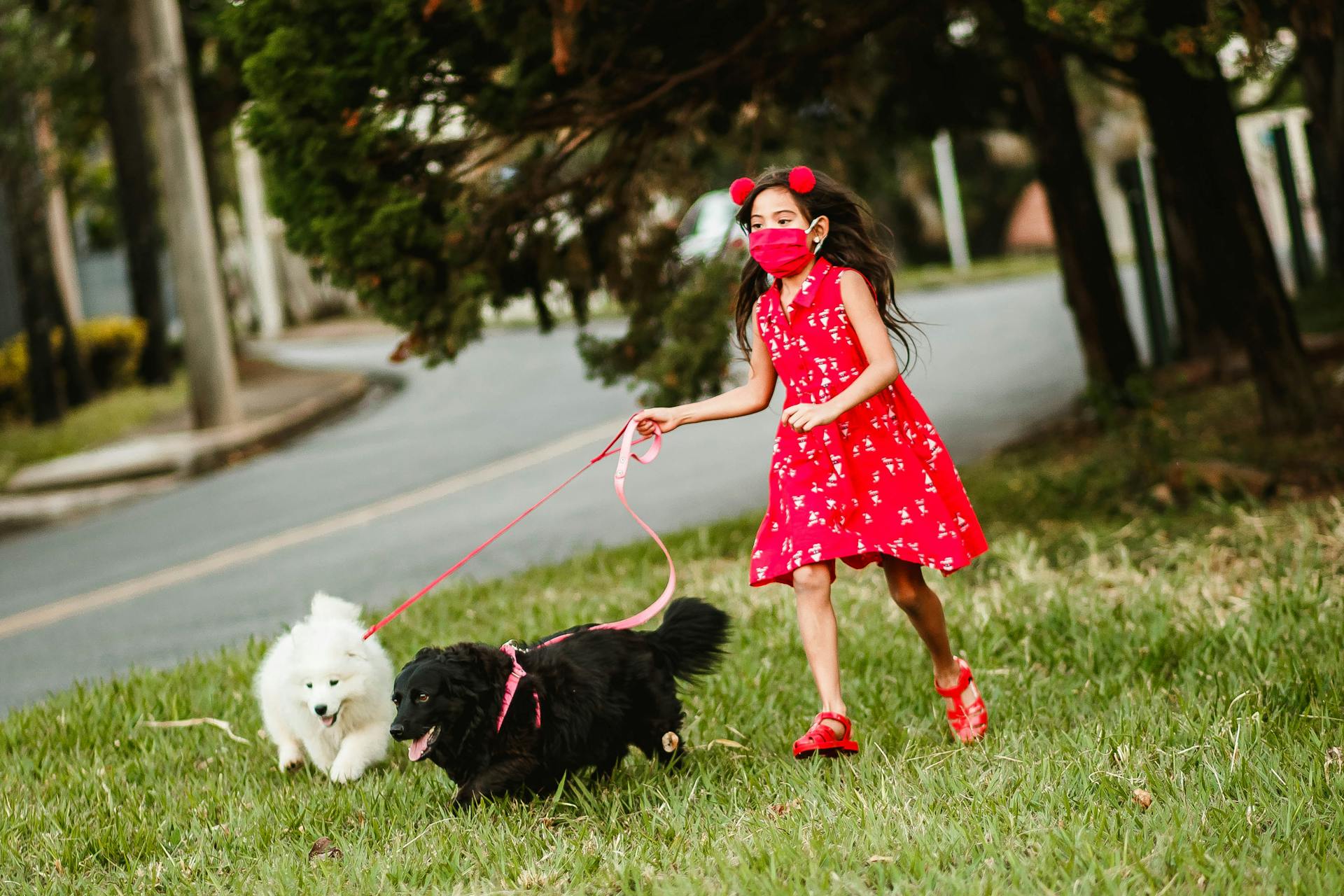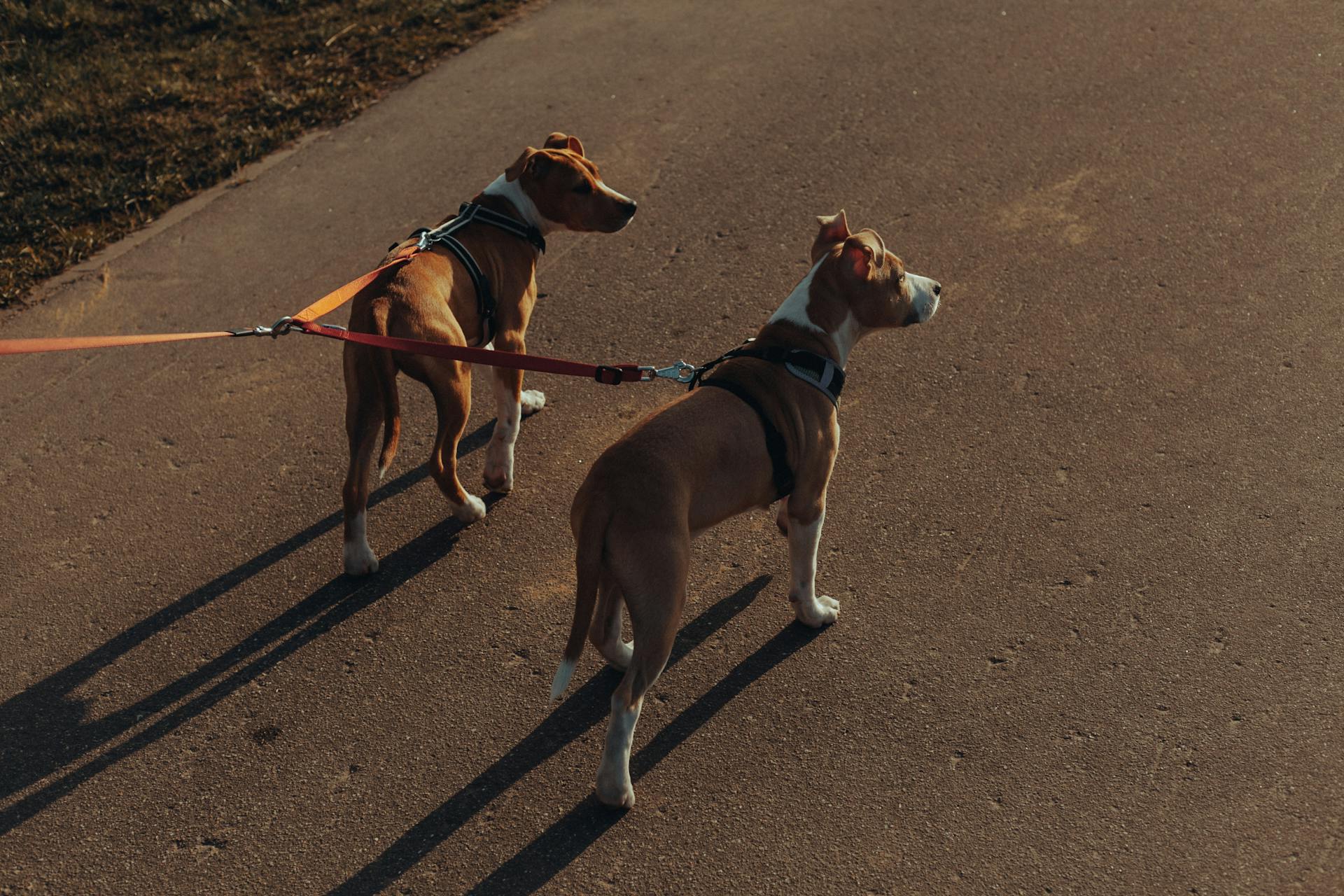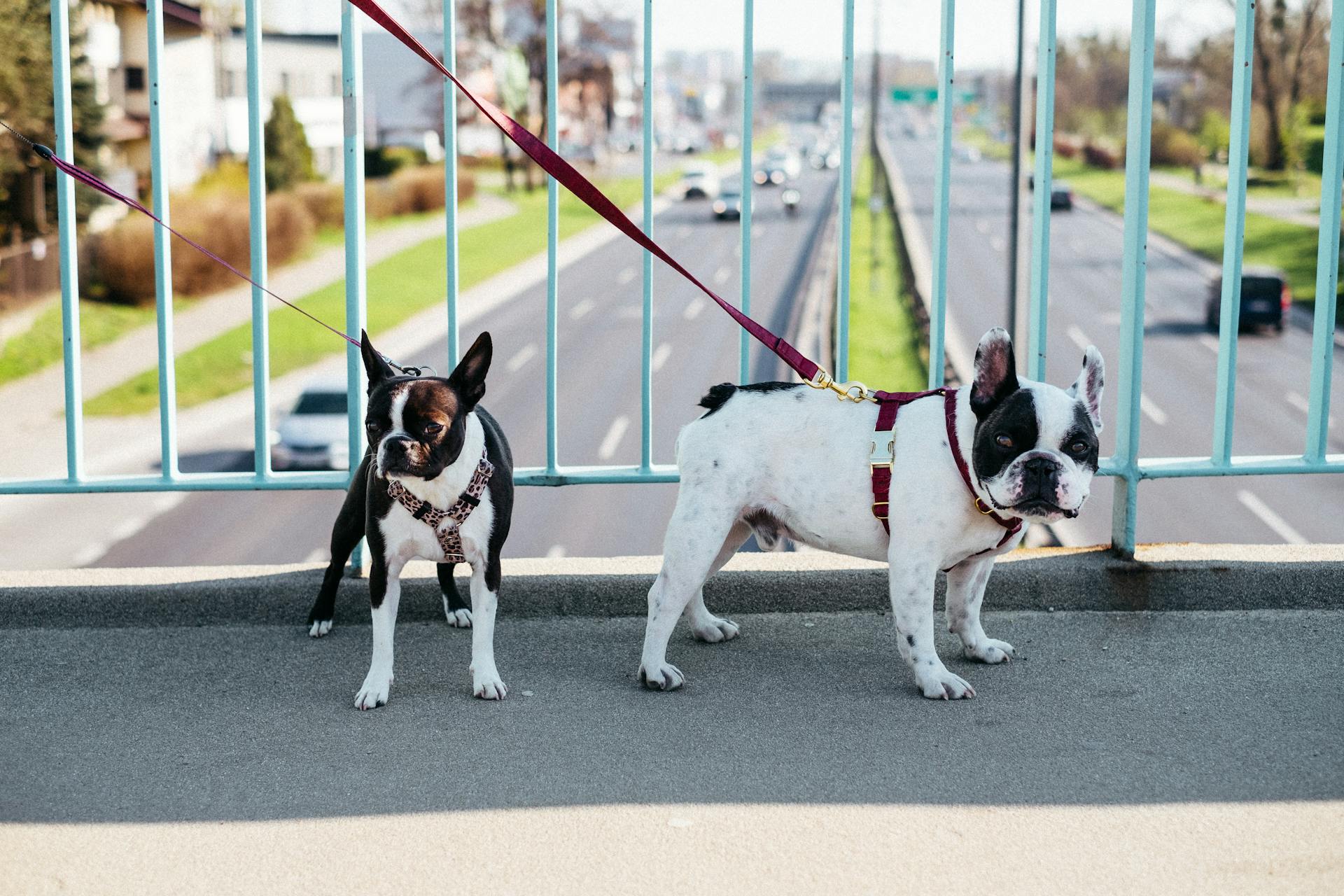
Dogs pulling on leash when walking is a common issue many pet owners face. It can be frustrating and even lead to injuries for both you and your dog.
The main reason dogs pull on leash is because they're driven by their instinct to chase and explore their surroundings. This is especially true for breeds like Golden Retrievers and Labradors, which were originally bred for hunting.
To overcome this issue, it's essential to understand that dogs don't know the concept of personal space. They view the entire environment as their territory and want to investigate every nook and cranny.
A key factor in leash pulling is the dog's level of exercise and mental stimulation. If your dog is not getting enough physical activity or mental challenges, they may resort to pulling on leash to release pent-up energy.
Curious to learn more? Check out: Dog Weight Pulling Harness
Understanding Pulling Issues
Dogs pull on the leash because they're excited to meet other dogs and people, and to smell all the outdoor scents.
Their natural instincts and behavior drive this behavior, which is often rooted in a desire to explore and assert dominance. Environmental stimuli like enticing scents, sights, and sounds can trigger their urge to pull.
A dog's surrounding can heavily influence leash pulling, and it's crucial to understand that this behavior is typically not a defiance against the owner but rather a response to the environment.
Excitement, curiosity, fear, and learning are all factors that might contribute to leash pulling. Here are some specific reasons why:
- Excitement: Dogs with pent-up energy may pull as an expression of excitement or anticipation.
- Curiosity: An unfamiliar or stimulating environment can spur a dog's curiosity leading to pulling on the leash.
- Fear: Anxiety or fear can also prompt a dog to pull towards safety or away from perceived threats.
- Learning: Without proper leash training, a dog might not understand the expectations of walking calmly on a leash.
Choosing the Right Equipment
Choosing the right equipment is crucial to discourage pulling and ensure a safe and enjoyable walk with your dog. A harness is essential for pets that pull, as it distributes pressure more evenly around the dog's body, reducing strain on the neck.
A chest-led harness is recommended, as it redirects pulling without causing discomfort. Proper use of equipment is also vital, with a snug-fitting harness that allows control without discomfort or restriction of movement.
Recommended read: Pulling Dog
When selecting a leash, choose one that is 6-10 feet in length, offering control and freedom. A leash should be comfortable to hold while providing enough strength to manage your dog's movements.
Here are some key considerations to keep in mind when choosing the right equipment:
Equipment Selection
Choosing the right equipment is crucial for enjoyable and safe walks with your dog. A proper harness can prevent pulling and ensure that walks are pleasurable for both you and your pet.
Selecting the right equipment is paramount for enjoyable and safe walks with your dog. Proper gear can prevent pulling and ensure that walks are pleasurable for both you and your pet.
A harness is essential for pets that pull, as it distributes pressure more evenly around the dog's body, reducing strain on the neck. The chest-led harness is recommended, as it redirects pulling without causing discomfort.
You should choose a snug-fitting harness that allows control without discomfort or restriction of movement. Leashes should be kept at a manageable length, around 4 to 6 feet, to provide ample guidance without being overbearing.
A different take: Pull Dog Harness
A standard 4-6 ft lead is recommended for teaching boundaries and loose leash walking. This will allow you to set a firm boundary for your dog and give you more control when you come across a fun distraction.
A head collar is a cruelty-free way to ensure that your dog not only won't pull but can't pull strongly enough or keep the leash tight enough to bowl you over. By using a head collar, your dog's pulling will cause its head to turn.
Here are the different types of harnesses mentioned in the article:
Remember, the type of leash you choose will depend on where and how you are training. A common mistake is using a retractable leash, which is not ideal for teaching boundaries and loose leash walking.
Take a look at this: Dog Leash
Choosing the Right Environment
Choosing the right environment for training is crucial for a productive and positive experience with your dog. Dogs are easily distracted, excited, and spooked, so it's essential to pick an enclosed space that is free of distractions.

Pick an environment that suits your dog's level of attention and experience, and work on obedience in a low-distraction setting where your dog can focus on you. You want to be the most important thing to your dog, and everything on the walks should be neutral to them unless a cue is given to interact.
Start by working in a quiet area and gradually introduce small distractions at a distance, treating your dog while you approach them to associate them with a reward. This will help your dog learn to stay focused on you amidst distractions.
Choosing the right time and place for training is also essential. Avoid busy walking paths or packed dog parks, as they can overwhelm your dog and make it difficult for them to stay focused on you.
Right Approach and Tools
To encourage loose leash walking and minimize your dog's pulling, you should use the right tools. This includes ensuring you get the right size collar or harness for your dog, as stated in Example 1.
You need to take a reward-oriented approach to train your dog to walk nicely on the leash. This means preventing them from getting where they're trying to go and rewarding good behavior, as explained in Example 2.
The American Kennel Club supports training that reinforces good behavior, and using tools that involve punishment, such as prong collars, electronic collars, and choke chains, are not the best way forward.
A no-pull harness can be an effective tool to train your dog to walk nicely on a leash, as mentioned in Example 3. However, it's essential to choose the right style for your dog's shape and behavior.
Here are some key points to consider when choosing the right tools for walking:
Remember, the goal is to find a tool that works for you and your dog, and to use it in conjunction with a reward-oriented training approach.
Right Tools
Choosing the right tools for walking your dog is crucial to ensure a safe and enjoyable experience for both you and your furry friend. A no-pull harness can be an effective option to train dogs to walk nicely on a leash.
Harnesses can reduce the pressure and stress placed on your dog's neck, while a collar will prevent chafing and pressure on their shoulders. A collar should still be worn to display their tags.
Avoid using a choke chain, prong collar, or electronic collars, which can make a dog pull harder and make them more fearful. Instead, opt for a head collar, which can be a cruelty-free way to ensure your dog doesn't pull strongly enough to bowl you over.
Here are some key things to consider when choosing the right tools:
Remember, the right tools can make all the difference in your dog walking experience. By choosing the right harness or collar, you can reduce the pressure and stress on your dog's neck and shoulders, and help them learn to walk nicely on a leash.
Expert Tips
As you're learning the right approach and tools for training your dog to walk nicely on the leash, it's essential to consider the expert advice available. The American Kennel Club supports training that reinforces good behavior.
Here's an interesting read: Leash Training a Rescue Dog
Using a reward-oriented approach is key. This means preventing your dog from getting to what they want when they pull, and rewarding them for good behavior. Prong collars, electronic collars, and other tools that involve punishment are not always the best way forward.
Head collars, like Gentle Leaders, can be an effective option for some dog owners. They work by directing the dog's head in the desired direction, allowing you to break their line of sight from what they're pulling towards.
If you're considering using a head collar, be aware that they require more training for your dog to adapt. They also eliminate pressure on the neck and chaffing from harnesses, but can be harmful if used improperly.
Slip leads are another useful tool for teaching your dog the concept of pressure on and pressure off. When they pull, they feel pressure, and when they relax or slow down, the pressure is alleviated. This technique allows you to reward or praise your dog as they learn.
A dog trainer will often recommend avoiding harnesses, especially for strong pullers, as they can cause damage to the dog's shoulders over time. If your dog's harness is causing discomfort, you might want to try using a collar on their neck instead.
Ultimately, every dog is unique, and what works for one may not work for another. Be patient and persistent, and remember that the minute your dog starts to pull on the leash, you should instantly stop the leash training exercise and walk away.
If this caught your attention, see: Dog Leash Types
Teaching Walking and Behavior
Teaching walking and behavior is a crucial part of dog training. Consistency is the cornerstone of effective dog training, and it's essential to apply the same rules and commands every time your dog is on a leash.
To teach loose-leash walking, start in a distraction-free environment to establish the behavior. Each time your dog maintains a loose leash, mark the behavior with a cue word and reward them. This helps the dog associate the relaxed leash with positive outcomes.
A front-clip harness can be an effective tool in discouraging pulling. You can also use positive reinforcement, rewarding your dog for strolling calmly beside you.
To manage your dog's excitement during walks, exercise them before walks to reduce excess energy and excitement. This will make it easier for them to focus on you and walk calmly.
It's essential to remember that your dog reacts based on instinct, and for most dogs, that instinct is to pull towards exciting things. Gradually increase distractions and reinforce good behavior to help your dog learn to walk calmly.
Here are some key techniques to teach your dog to walk on a loose leash:
- Use a properly fitting harness and leash
- Practice in a controlled environment
- Reward your dog for strolling calmly beside you
- Gradually increase distractions
- Reinforce good behavior
Consistency and Progress
Consistency is key when training your dog to walk without pulling on the leash. Consistency sets clear expectations for the dog, reducing confusion and reinforcing good behavior.
Consistency in training involves applying the same rules and commands every time your dog is on a leash. This could involve using a no-pull harness and giving the same cue every time your dog begins to pull.
A dog that is trained consistently understands what is expected and is less likely to pull on the leash. Frequent practice and repetition solidify these behaviors, leading to a dog that is more attentive and responsive to commands during walks.
Tracking progress methodically can help maintain patience, as you can see tangible results over time, reinforcing confidence in the training process. Use a journal or checklist to note improvements and areas where your dog still struggles.
Consistency is essential to maintain training success with your dog. This involves consistent practice and addressing any setbacks promptly to ensure that positive behaviors are reinforced and undesirable ones are corrected.
Regular, consistent reinforcement of commands and expectations is crucial to ensure that the good leash manners your dog has learned remain ingrained in their behavior.
See what others are reading: Obedience Dog Training
Troubleshooting Tips
Every dog has its own unique personality traits, and some will master walking on a leash quickly, while others become a greater challenge.
Accepting that every dog is different is crucial when teaching loose leash walking. Some dogs will pick it up fast, while others will require more effort.
To tackle the problem differently, you need to understand that your dog knows he's supposed to stay with you and will eventually catch up to you if you walk away.
Walking away from your dog when they start to pull on the leash is a surprisingly effective technique. This method shows your dog that pulling gets him nowhere.
Your dog will eventually learn to pay attention to you and stop pulling on the leash because his action of pulling gets him nowhere.
Consider reading: When Do Dogs Start Walking
Special Cases and Situations
Dogs that are easily distracted by their surroundings are more likely to pull on the leash. This is often the case for dogs with high prey drive or those that are still in the puppy stage of development.

Excitement and anxiety can also cause dogs to pull on the leash, especially if they're not properly socialized to new environments. This can be a major issue for city dwellers who frequently walk their dogs through crowded areas.
Some breeds, such as Siberian Huskies and Alaskan Malamutes, are naturally prone to pulling due to their strong instinct to run and chase. Their high energy levels and strong prey drive can make them difficult to walk on a leash.
Dogs that are not getting enough physical and mental stimulation may also pull on the leash, as they have excess energy to burn off. This can be a sign that they need more exercise or playtime.
In some cases, dogs may pull on the leash due to underlying medical issues, such as arthritis or hip dysplasia, which can cause them to move more quickly and erratically.
For your interest: Sled Dog Pull
Sources
- https://www.neewadogs.com/blogs/blog/how-to-stop-dog-from-pulling-on-leash
- https://roguepetscience.com/blogs/dog-training/how-to-stop-dog-from-pulling-on-leash
- https://blog.homesalive.ca/dog-blog/how-to-stop-a-dog-from-pulling
- https://www.dvm360.com/view/better-walk-training-dogs-not-lunge-growl-and-pull-leash
- https://www.animalhumanesociety.org/resource/teach-your-dog-walk-loose-leash
Featured Images: pexels.com


